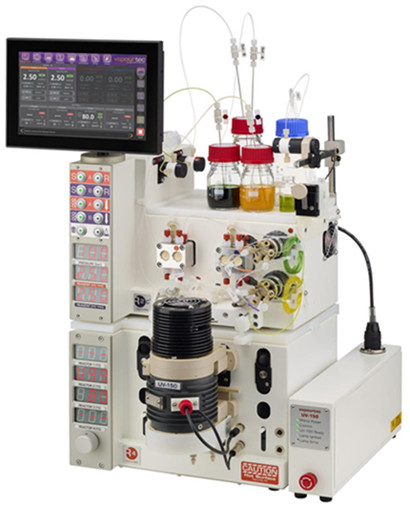Home > News > Flow Photochemistry Enables Peptide Breakthrough
Flow Photochemistry Enables Peptide Breakthrough
Vapourtec R-Series and UV-150 photochemical reactor are used by scientists at Novo Nordisk for functionalisation of peptides and proteins
Vapourtec’s R-Series flow chemistry system, equipped with a UV-150 photochemical reactor, has been cited in research by scientists* at Novo Nordisk in the C-terminal α-amination of peptides and proteins from cysteine-extended polypeptide precursors [1].
Published in a paper in Nature Communications entitled ‘Photochemically-enabled, post-translational production of C-terminal amides’, the process involved three steps: cysteine thiol substitution with a photolabel, photoinduced decarboxylative elimination and cleavage of the enamide. Gram-scale synthesis was achieved on a recombinantly prepared peptide YY analogue. This flow reaction demonstrates the potential for amidated drug leads to enter development that would not be viable on commercial scale using existing technology.

In recent years, peptide-based therapies have enjoyed a renaissance due to progress made in the world of chemical and structural biology. In addition, recent advances addressing the limitations of peptide-based therapeutics, particularly in relation to short half-life and poor oral bioavailability, have come to the fore [2].
Peptides are traditionally synthesized through the use of SPPS (solid-phase peptide synthesis). When scale-up is required for high-volume demand, this approach may not be feasible. In this case, the use of recombinant production offers an alternative approach. However, peptides containing a C-terminal α-amide are particularly challenging to prepare using this method.
In this work, built on a prior disclosure by the Baker group [3], C-terminal cysteine residues were conjugated to the photolabile reagent 4-chloro-7-nitrobenzofurazan (NBD-Cl). Upon irradiation, this intermediate underwent a decarboxylation–fragmentation sequence, to provide a C-terminal N-vinyl amide.
The vinyl group could be removed to reveal the C-terminal α-amide either through acid hydrolysis or an inverse electron demand Diels-Alder (IEDDA) reaction, which allows compatibility with peptides and proteins sensitive to acid (e.g. glycopeptides).
On small scale (250 μM), this protocol was successfully used in batch for the synthesis of the GLP-1R agonist, GLP-1(7-36), one example of an important class of therapeutic peptides that includes the marketed drugs exenatide and lixisenatide, as well as in the other biologically-relevant targets including gastrin-releasing peptide, osteocrin and bulevertide.
A scaled-up process, using Vapourtec’s R-Series system in conjunction with the UV-150 photochemical reactor module, was proven to be efficient. One example demonstrated the preparation of an analogue of PYY, an amidated gastrointestinal hormone that is involved in the regulation of appetite [4, 5].
Using 4 g of the starting material, the C-terminal cysteine was reacted with NBD-Cl then subjected to photo-initiated cleavage under flow conditions (430 nm, 24 W, 99% lamp power, 2 mL coil, 20 mL/min, tres = 6 secs). Enzymatic digestion of the N-terminus and conversion of the enamide ,using phosphoric acid, to the intended amidated peptide was accomplished in 20% overall yield after a single final purification.
A second example showed conversion of 12 g of a recombinant 81 amino acid GLP1R-amylinR co-agonist precursor peptide to the target peptide amide in 78% yield, rapidly and cleanly.
In summary, Harris and co-workers have disclosed a highly efficient approach to convert peptides and proteins to their corresponding C-terminal amides in good yield and quickly. It was noted that this work enabled C-terminal amidation (photolabeling and photochemical conversion) to be undertaken in one day, which is a significant improvement on current capabilities.
The substrate scope is broad, and both synthetic and recombinant peptides are tolerated.
The authors noted that without the photochemical flow process this reaction would simply not be viable on commercial scale, clearly showing the advantage of using enabling technologies and, in particular, flow photochemistry from Vapourtec.
For more information visit www.vapourtec.com.
For more information please contact Rob Wilkinson (gopromomarketing@gmail.com / 07909916770)
References:
* Authors: David Hymel, Felix Wojcik, Kim S. Halskov, Wouter F. J. Hogendorf, Sydnee C. Wong, Ben M. Williams, Asmus R. Mortensen, Nick Cox, Ayesha Misquith, Nanna B. Holländer, Finn Matthiesen, Suneet Mehrotra and Michael R. Harris
[1] Photochemically-enabled, post-translational production of C-terminal amides. (D. Hymel, F. Wokcik, K. S. Halskov et al., Nature Comm., 2024, 15, 7162). https://doi.org/10.1038/s41467-024-51005-5
[2] The current state of peptide drug discovery: back to the future? (A. Henninot, J. C. Collins, J. M. Nuss, J. Med. Chem., 2018, 61, 1382). https://doi.org/10.1021/acs.jmedchem.7b00318
[3] Photochemically re-bridging disulfide bonds and the discovery of a thiomaleimide mediated photodecarboxylation of C-terminal cysteines. (D. A. Richards, S. A. Fletcher, M. Nobles et al., Org. Biomol. Chem., 2016, 14, 455). https://doi.org/10.1039/C5OB02120K
[4] The Hitchhiker’s guide to flow chemistry. (M. B. Plutschack, B. Pieber, K. Gilmore, P. H. Seeberger, Chem. Rev., 2017, 117, 11796). https://doi.org/10.1021/acs.chemrev.7b00183
[5] Technological innovations in photochemistry for organic synthesis: flow chemistry, high-throughput experimentation, scale-up, and photoelectrochemistry. (L. Buglioni, F. Rayemenants, A. Slattery, S. D. A. Zontag, T. Noël, Chem. Rev., 2022, 122, 2752). https://doi.org/10.1021/acs.chemrev.1c00332
Related News
- New Members in Eppendorf's epMotion® Family – 4-Channel Dispensing Tools 4/29/2025
- Application Optimized Satellite and Space Platform Lenses 4/24/2025
- Sensitive and Specific DUB Enzyme Assay Kits 4/24/2025
- Biocompatible Valve Solutions for Life Science Instrumentation 4/23/2025
- PCR Plates Designed to Improve Consistency of Results 4/22/2025
- ZHUOYUE Launches the ZYS Intelligent Ultrapure Water System 4/17/2025
- Wildcat Laboratory Solutions Partners with Leading Lab Sustainability Innovator 4/16/2025
- Cold Chain Technologies Looks to “Go Further” with Launch of Universal CCT Tower 4/16/2025
- Syntegon Launches New MLD Advanced for RTU Syringes 4/15/2025
- Alfa Chemistry Expands into Marine Chemistry: A Dive into Marine Extracts, Oils, 4/14/2025


